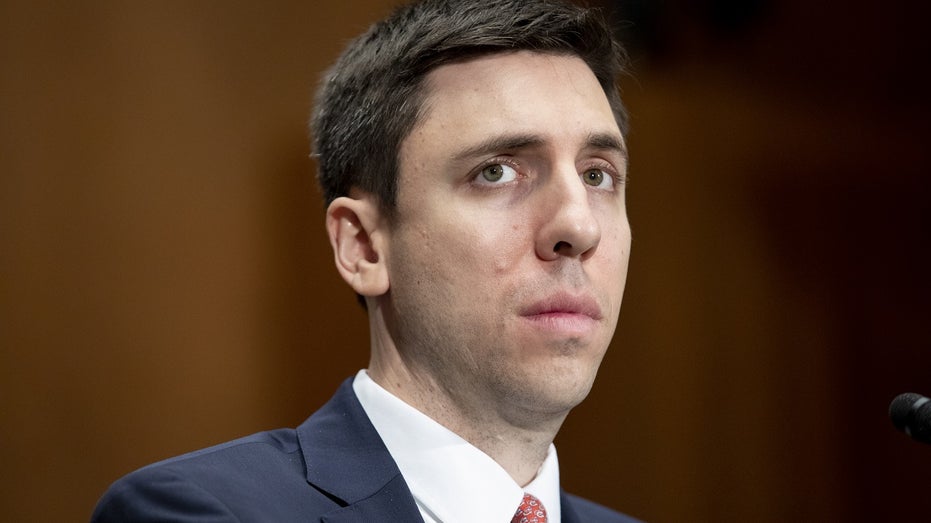FDIC official says agency was slow to sell failed SVB
Vice Chairman Travis Hill says changes made by the regulator might have hurt access to timely data
Rep. Mike Lawler pushes back on FDIC issuing a 100% guarantee on deposits: Is it sufficient?
Rep. Mike Lawler, R-N.Y., joined ‘Cavuto: Coast to Coast’ to discuss the Silicon Valley Bank collapse, arguing that the Federal Reserve did not act with the speed it should have.
A top Federal Deposit Insurance Corp. official said the agency could have moved more quickly to find a buyer for Silicon Valley Bank after it failed last month, suggesting a lack of urgency worsened the crisis that sent tremors through the banking system.
Travis Hill, the FDIC’s vice chairman and one of two Republicans on its five-member board, said the agency was too slow in setting up a platform for potential bidders to look at SVB’s finances after its closure on March 10. The so-called data room allows would-be buyers to perform due diligence on a bank’s business.

Travis Hill, member of the board of directors of the Federal Deposit Insurance Corporation (FDIC) nominee for US President Joe Biden, during a Senate Banking, Housing, and Urban Affairs Committee nomination hearing in Washington, DC, US, on Wednesday (Photographer: Amanda Andrade-Rhoades/Bloomberg via Getty Images / Getty Images)
Mr. Hill also said in a speech Wednesday that policy changes made by FDIC Chairman Martin Gruenberg might have hurt the regulator’s access to the bank’s data. He said it was a mistake to scrap a plan to develop a new reporting prototype aimed at providing the agency with more timely and targeted data about banks’ credit exposures and deposit information.
"This type of tool not only could help expedite populating a data room for a failed bank, it also would give the FDIC access to much higher-quality data to monitor broader trends, such as deposit flows in times of stress," Mr. Hill said. "Unfortunately, this project was discontinued."
WARREN BUFFETT ON BANKING CRISIS: ‘NOBODY IS GOING TO LOSE MONEY ON A DEPOSIT IN A US BANK’
A spokesman for Mr. Gruenberg and the FDIC declined to comment.
Regulators took control of Santa Clara, Calif.-based SVB on March 10. The collapse sparked a panic that led to the weekend failure of Signature Bank and an intervention by financial regulators aimed at easing fears that depositors would flee smaller lenders.

A worker (C) tells people that the Silicon Valley Bank (SVB) headquarters is closed on March 10, 2023 in Santa Clara, California. Silicon Valley Bank was shut down by California regulators and put in control of the FDIC. (Justin Sullivan/Getty Images / Getty Images)
More than two weeks after SVB’s rapid collapse, the FDIC sold most of the firm’s assets to First Citizens Bancshares Inc.
Some lawmakers have questioned why the FDIC didn’t sell SVB immediately after it failed, which they said might have allowed the federal government to avoid intervening to protect all depositors at that bank and Signature.
SMALL BUSINESSES STRUGGLING TO GET CREDIT AFTER SVB COLLAPSE
In his speech Wednesday, Mr. Hill said that once SVB reopened March 13 as a "bridge bank"—created by federal regulators to manage the failed bank’s deposits and assets—the value of its franchise deteriorated rapidly as depositors withdrew funds and customers moved their banking relationships elsewhere.
"This underscores a critical lesson for regional-bank resolutions: Once the bank fails, the government must be proactive in finding an acquirer as quickly as possible," he said.

An FDIC sign is posted on a window at a Silicon Valley Bank branch in Wellesley, Mass., on Saturday, March 11, 2023. (AP Photo/Peter Morgan / AP Newsroom)
The FDIC was pressed for time after SVB failed, people familiar with the matter have said. Eventually, officials ran out of time to close an auction for SVB before markets in Asia opened.
Mr. Gruenberg, testifying before Congress last month, said the FDIC received two bids to buy SVB the weekend it failed, one of which he said wasn’t valid because it lacked approval of the would-be buyer’s board. The FDIC determined that the other offer would have cost it more than liquidating the bank.
GET FOX BUSINESS ON THE GO BY CLICKING HERE
The FDIC had more leeway to market SVB once regulators determined that the bank’s failure posed a systemic risk, allowing the agency to sell the firm with loss-sharing agreements and other deal sweeteners. After that happened, and firms had time to examine SVB, the FDIC received more than 27 bids from 18 firms, the agency has said.




















